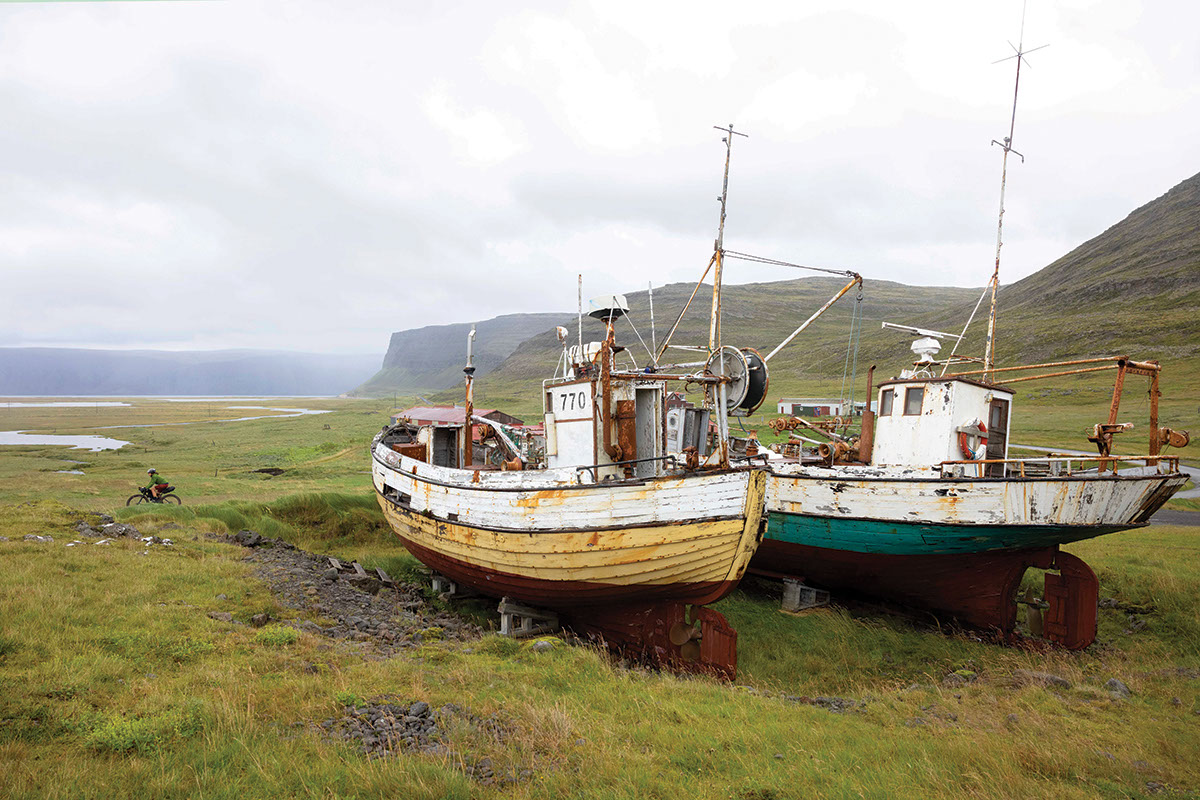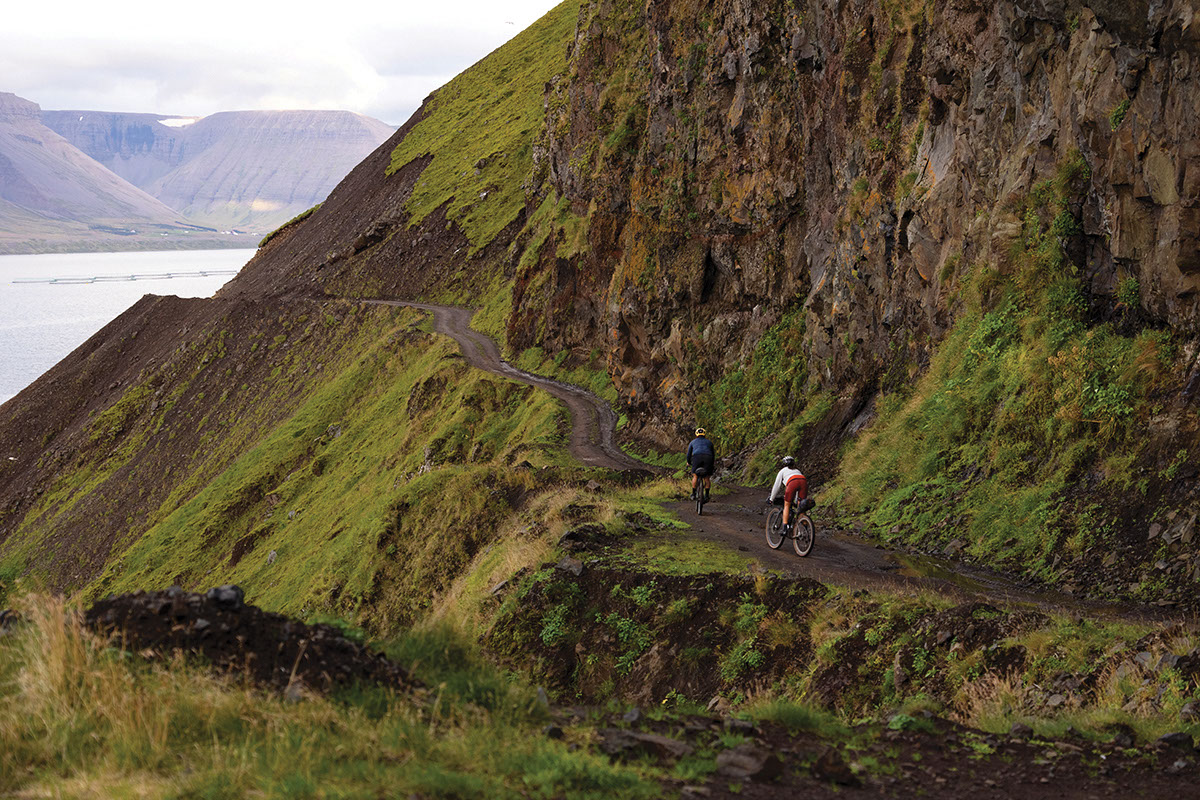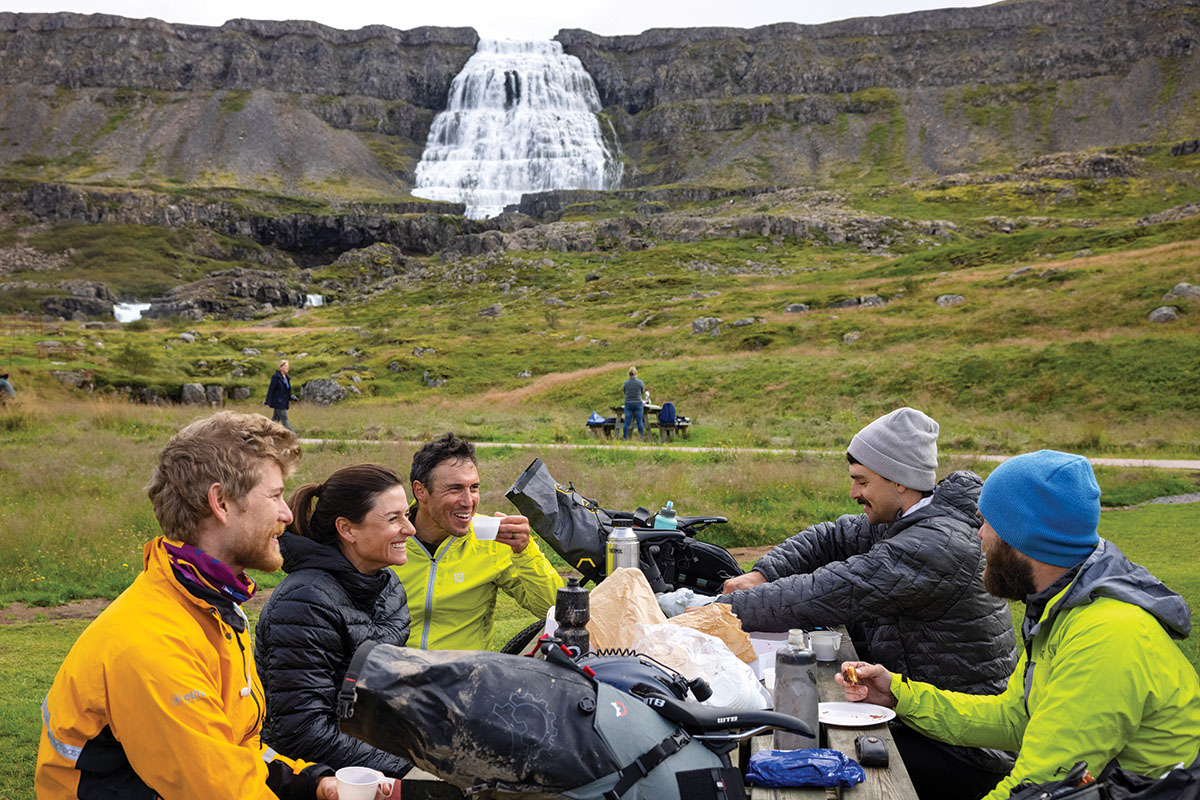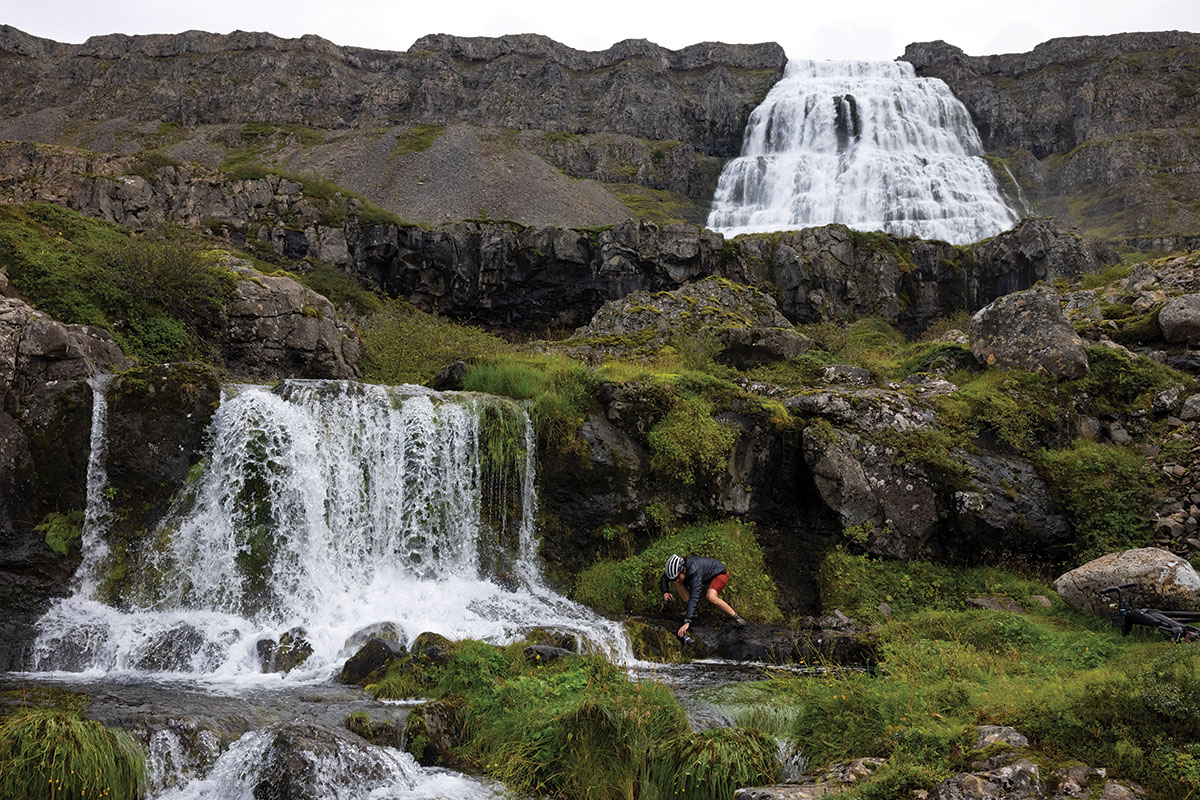The Westfjords Way
This article first appeared in the Dec. 2021/Jan. 2022 issue of Adventure Cyclist magazine.
In the Westfjords, in the far northwest corner of Iceland, water dominates the way of life. It manifests as hot springs, waterfalls, rivers, and the sea. Fishing is the primary industry. As recently as 1960, these villages were isolated, with no road system, only boat access. Many of the locals lived underground in turf homes to protect themselves from the wind. With World War II and the Cold War came the need for a road network to transport people and goods. Still, only 7,000 people live in the Westfjords, a region that is half the size of Switzerland, and 2,500 of them are in Ísafjörður, the largest town in the area. Traffic is light. The land remains mostly wild.
The Westfjords Way is a 1,100-kilometer (683-mile) mixed tarmac and gravel loop around the Westfjords of Iceland, one of the most remote regions in the country. The route traces the fjords, crossing scenic mountain passes to connect back to the sea. Road surfaces are generally smooth. There are plenty of restaurants and stores along the way for resupply, and if you cover 60 to 80 miles a day, you can find lodging every night. Camping is available, but fair warning: the strong wind can make setting up a tent very challenging.
We traveled to Iceland in early September with a small group, including Payson McElveen and Nichole Baker from Durango, Colorado, to scout the Westfjords Way self-supported by bike. An American photographer, Chris Burkard, and Birna Jonasdottir from Visit Westfjords, the local tourism bureau, have been working on the route design for three years. Our schedule allowed for eight days on the bike and we rode our hearts out, stopping each night at lodges and cabins to recenter for the following day. A couple of locals, Bergur and Tyler, joined us for short stretches.
Meant to be easy to re-create and modify, the Westfjords Way will be Iceland’s first official bike touring route. It’s all on public roads and will be free to access any time of the year, though the optimal season is June through September. We have ambitions to partner with Visit Westfjords to host an ultra-distance stage race on the route late next June, a week after summer solstice when it’s light all night long.

Iceland is dynamic. Wind shapes the experience and landscape. It moves weather patterns through, affecting how the light hits the land. Days can feel like weeks as everything is constantly changing. It’s a magnificent show to absorb from the seat of a bicycle.
Due to these potentially harsh conditions, I highly recommend designing Iceland bike trips with resources and shelter in mind. It’s good to get a break from the wind and weather to rejuvenate for the next stretch. The natural beauty is remarkable, but there’s a risk of getting mentally, physically, and emotionally beaten down by exposure to the elements. Luckily, the locals are friendly and helpful. They know how difficult travel can be and welcome visitors with open arms.
Bike travel and local tourism are fantastic partners. I hope to see and be part of more official touring routes around the world, particularly those that include dirt roads. When we start looking for remote roads through mountains, we find beauty and bravery and reaffirm our connection to the earth.

Woken by an alarm, a week into the ride, no amount of eye rubbing or face washing or coffee will really wake me up. My senses come back when I’m in the saddle. The wind carries moisture that coats my face and legs. Everything else is covered. From Patreksfjörður, we start up a paved mountain pass. It’s a steady 400-meter (1,312-foot) climb, and I’m jamming on the pedals, wet inside and out with effort. Over the crest is a view of the sea with the road snaking down. Visibility is expansive as there aren’t any trees this far north. We’re just below the Arctic Circle. The road jets down. I don’t stop to layer up and my temperature plummets. I’m chasing Chris down the mountain. He’s a hammer on wheels. At the base of the climb, along the sea, we take a quick left and detour off the route to Bíldudalur. We’ve been promised waffles at the local shop-café.
Icelanders prepare waffles in heart-shaped irons. The batter is thin and light. These come with rhubarb jam and homemade whipped cream in a pressurized metal canister. We serve ourselves. Many meals are family-style and everything is delicious. I’m convinced that there’s no bad food in Iceland.
We fill coffee from the carafe and the café owner points across the street.
“That’s where I was born,” he said. His face splits into a smile revealing the gap between his front teeth. “Are you cold?”
He brings us fleece blankets and layers waffle on top of waffle.

We regain our strength to face more exposure. Leaving town, the rain breaks into sunshine and the route traces a fjord past a waterfall, an idyllic A-frame, and a public hot spring. The hot spring has a rectangular warm pool, changing rooms, and a hot bath. It’s warm outside and we don’t stop to soak. We’re onto the next climb; this one’s on dirt. Black gravel forges through green moss. I stop at the top to fill up my water and this time I put on a jacket. On the way down, I spot the largest waterfall I’ve ever seen. It must be as wide as a football field. I get to the turnoff and I don’t hesitate. There’s no way we won’t stop for this.
It’s called Dynjandi, a cascade that flows fans of clear water. At the base, we feast on a picnic of pastries and sandwiches and then push our bikes up as close as we can get to the waterfall. Looking over the edge makes me feel shaky. There’s just so much power.
The next stretch wraps around a peninsula. Pavement turns into dirt, then doubletrack, crossing a knee-deep stream four times. As we go along, the route gets progressively rougher with rocks embedded into the dirt. The edge of the peninsula doesn’t technically connect — story has it that a frustrated farmer took his tractor and carved it out. It’s only passable by car at low tide, but easy to scoot by on a bike. The cliff faces are lush with growth and almost look tropical. The weather is holding, but the sun is getting lower. I imagine in midsummer on an evening like this with daylight into the late hours, you’d never want to stop riding. It’s winding doubletrack for another hour and then a fast, smooth road section to Þingeyri, a small fishing village on the water.

We stop in front of the green building with the green bus out back on the grass. The owner of Simbahöllin comes out to greet us.
“You must be hungry. Do you want to eat right away?”
“Yes, please!”
It must be nearly 9:00 PM. I change out of my wet clothes in the parking lot and go inside to the warmth. With wooden floors and white painted walls, it’s old and hip at the same time. There are half a dozen folks drinking beer, cozy on the couches. We take a seat, soaking in the day. The owner welcomes us to take drinks out of the fridge.
“Just write down what you had on this list.”
My wife Rue and I get cans of cold Boli, the local lager.
A friend of the owner has prepared us dinner. There are pots of lamb and shrimp curry, steaming basmati rice, a cabbage and carrot coleslaw, bread and butter, and carrot soup. We dish ourselves heaping bowls and take a seat at the long table.
We regroup and share stories, but we don’t stay too long. We’ll be back for breakfast before our final day. The owner has a guesthouse a hundred meters away and we pedal down the road to find our home for the night. It’s an old warehouse converted into a bunkhouse with a hot tub and a fleet of fat bikes.
I soak in the tub, take a shower, plug in my electronics, lay my wet clothing on the heater to dry, and fall asleep on a mattress in the loft. When I wake up, I don’t remember where I am. When I come to, I’m heartened by another day on the route. We’ll ride the old abandoned road back to Ísafjörður to complete the loop and officially finish when we jump into the sea at the harbor.
Riding in Iceland has a wide spectrum for weather and beauty. It can be scary and uncomfortable, but ultimately magical. Steam rises from the ground, water crashes down cliffs, and even the birds struggle to fly against the wind. At times, it takes a lot of energy and spirit to ride through the days, but the natural beauty makes it more than worth the effort.
Nuts & Bolts
Getting there
Several airlines fly to Keflavík International Airport, near Reykjavík, including Iceland Air, Lufthansa, Delta, JetBlue, United, and others. From Keflavík, take a 50-minute domestic flight to Ísafjörður, the main city on the loop. If you are already touring through the region, Iceland Air allows you to roll your bike, even loaded up with all your touring gear, onto any domestic flight without packaging.
When to go
To avoid harsh winter conditions, plan to visit in the summer months between June and September.
How long to vacation
Plan on this trip taking about two weeks, with two days for travel and eight to 12 days for riding. Of course, a few extra days for sightseeing and hot springs soaking is always a great idea.
What to pack
Be sure to bring layers, including rain gear and windbreakers. It’s possible to find lodging every night if you ride 60 to 80 miles per day. If you plan to camp, be sure to bring extra tent stakes and guylines to anchor yourself against the wind.
For more info: visit bikepacking.com/routes/westfjords-way for the route guide.

